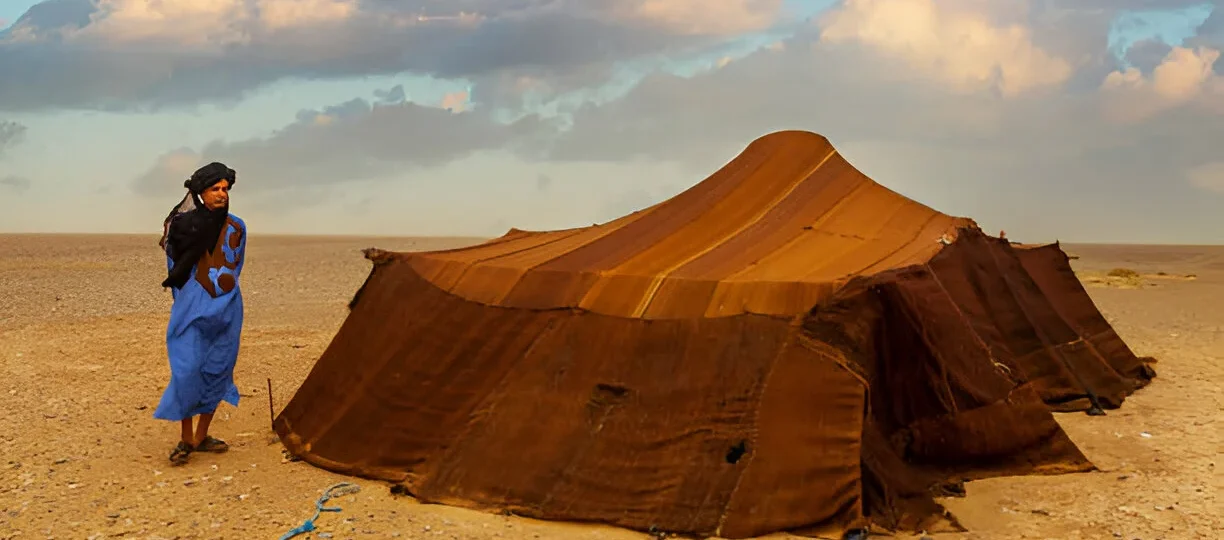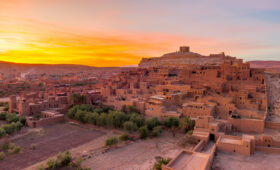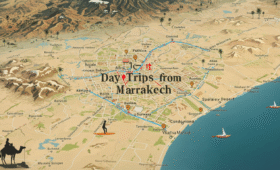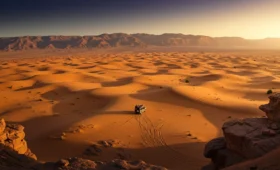Sahara desert trips from Marrakech are multi-day excursions that take travelers from Morocco’s popular Red City to the iconic golden sand dunes of the Sahara Desert. These journeys traverse the Atlas Mountains and pre-Saharan landscapes before reaching true Saharan environments where travelers can experience camel trekking, overnight desert camping, and immersion in nomadic culture. Sahara desert trips are essential for experiencing Morocco’s most iconic landscape that cannot be reached within a single day from Marrakech.
There are four main types of Sahara desert trips from Marrakech. Standard 2-3 day trips provide quick access to desert experiences at Zagora or Merzouga. Extended 4-5 day journeys offer more relaxed pacing with additional cultural stops. Luxury desert experiences feature premium accommodations and exclusive activities. Specialized themed tours focus on specific interests like photography, astronomy, or cultural immersion.
To plan effective Sahara desert trips from Marrakech, first determine your preferred trip duration, considering that the true Saharan dunes require at least 2-3 days to reach from Marrakech. After choosing the trip length, select your desert destination between Zagora (closer but smaller dunes) or Merzouga/Erg Chebbi (further but with spectacular large dunes). When preparing for your trip, pack essentials for extreme temperature variations between day and night, along with sun protection and appropriate footwear for sand.
Popular routes include the Ouarzazate-Zagora-Marrakech circuit for shorter trips and the more comprehensive Marrakech-Merzouga-Fes route for those continuing eastward. These trips represent significant extensions beyond simple day trips from Marrakech and can be incorporated into broader Morocco group tours or the popular Marrakech to Fes desert tour that traverses multiple regions.
What are Sahara Desert Trips from Marrakech?
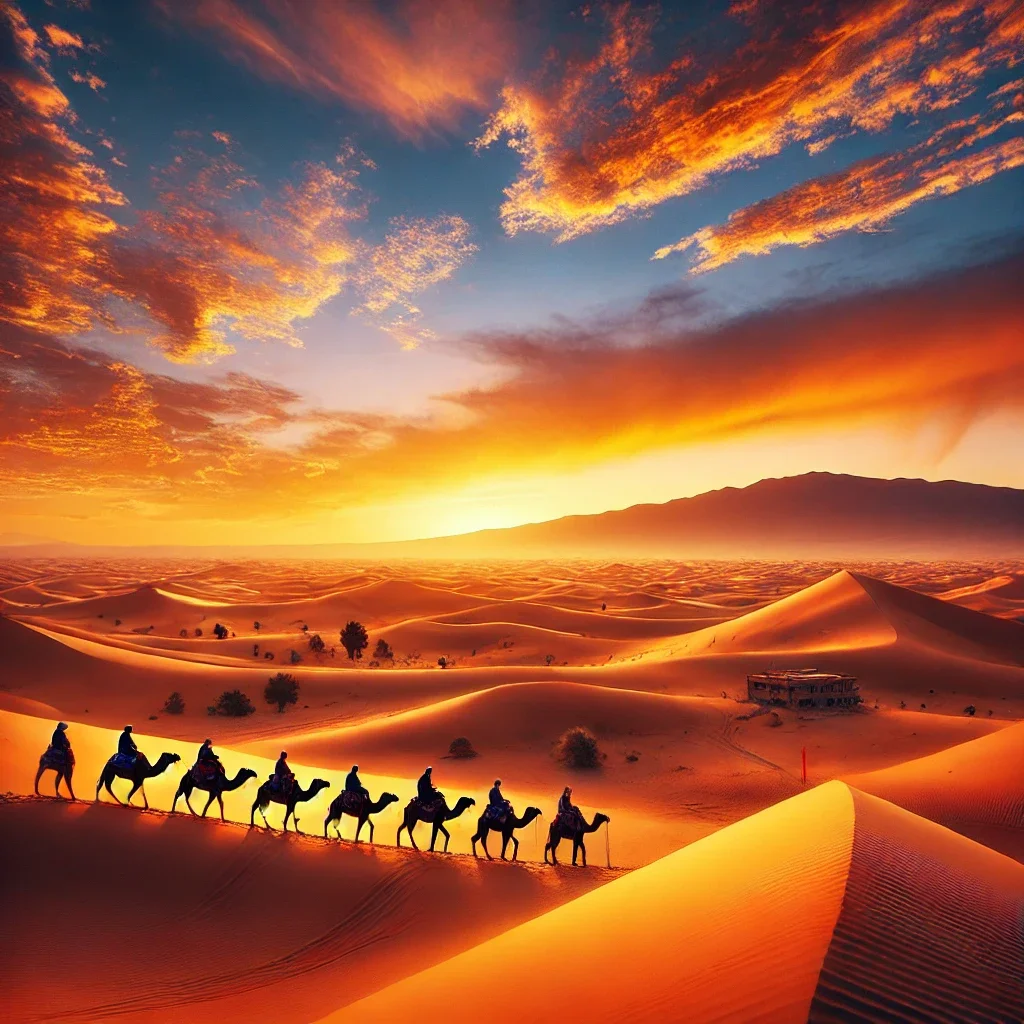
Sahara desert trips from Marrakech are multi-day journeys that take travelers from Morocco’s most popular tourist city to experience the iconic golden dunes of the Sahara Desert. These excursions typically span 2-5 days and traverse diverse landscapes including the High Atlas Mountains, historic kasbahs, dramatic gorges, and pre-Saharan oases before reaching the true Saharan environment. The itinerary includes transportation in 4×4 vehicles or minibuses, overnight accommodations in hotels or traditional riads en route, and at least one night camping in the desert, along with guided experiences and activities throughout.
Sahara desert trips work by following carefully planned routes eastward from Marrakech, covering significant distances (350-600 kilometers depending on the specific Saharan destination) across dramatically changing landscapes and climate zones. Since true Saharan dunes cannot be reached in a single day from Marrakech, these trips include strategic overnight stops at locations of cultural or natural interest. Upon reaching the desert edge, travelers transfer to camelback for a traditional desert experience, trekking into the dunes to reach desert camps where overnight accommodation and cultural activities await. Tours are operated by professional companies employing licensed drivers and guides knowledgeable about desert environments and traditions.
Taking Sahara desert trips offers numerous benefits for travelers. These journeys provide access to Morocco’s most iconic landscape – the golden sand dunes that feature prominently in Morocco’s international image but remain inaccessible to the majority of visitors who stay only in major cities. They facilitate immersive cultural experiences through interactions with Berber communities, nomadic groups, and desert dwellers maintaining traditional lifestyles.
Desert trips offer spectacular natural experiences including breathtaking landscapes, pristine night skies for stargazing, and the unique tranquility of vast open spaces far from urban centers. They also create opportunities for adventure activities unavailable elsewhere, from camel trekking and sandboarding to 4×4 excursions across varied desert terrain.
Standard shared tours gather 6-16 travelers in shared transportation following set itineraries with scheduled stops at major attractions. These cost-effective options typically use mid-range accommodations and standard desert camps with shared facilities. Premium small-group tours limit participation to 4-8 travelers, offer higher-quality accommodations, and include more personalized attention from guides. Private exclusive tours provide dedicated vehicles and guides for your travel party with flexible itineraries and premium accommodations throughout, allowing customization based on specific interests.
What are the Types of Sahara Desert Trips from Marrakech
Sahara desert trips from Marrakech are multi-day journeys that transport travelers from the bustling Red City to the iconic golden dunes of the Sahara. The 4 main types of Sahara desert trips from Marrakech are:
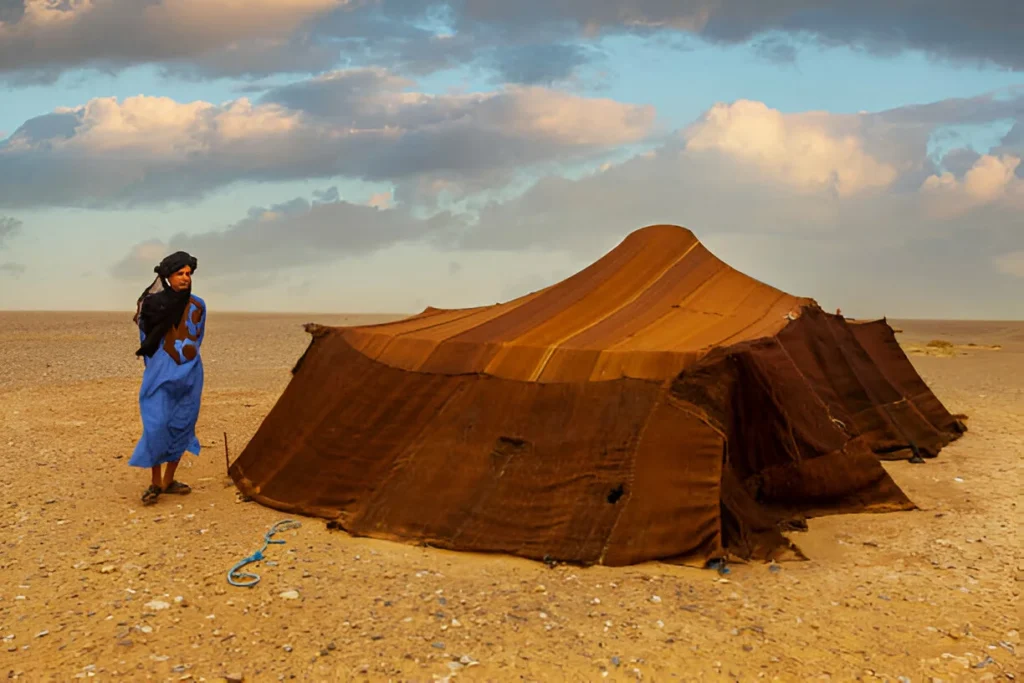
- Standard 2-3 Day Trips: Efficient journeys providing essential desert experiences with one night in the desert, either to the more accessible Zagora region (2 days) or the more impressive Erg Chebbi dunes near Merzouga (3 days).
- Extended 4-5 Day Journeys: More comprehensive itineraries with relaxed pacing, additional cultural stops, and sometimes two nights in different desert locations, allowing deeper desert immersion and exploration.
- Luxury Desert Experiences: Premium journeys featuring boutique accommodations, luxury desert camps with private facilities, gourmet dining, and exclusive activities like private cultural performances or specialized guides.
- Specialized Themed Tours: Focused experiences built around specific interests such as photography (timed for optimal desert light conditions), astronomy (emphasizing night sky observation), cultural immersion (with extended interactions with nomadic communities), or adventure activities (incorporating extended camel treks, sandboarding, or 4×4 excursions).
These multi-day excursions represent significant extensions beyond simple day trips from Marrakech and can be incorporated into broader Morocco group tours or the popular Marrakech to Fes desert tour that continues eastward rather than returning to Marrakech.
Type 1: Standard 2-3 Day Desert Trips
Standard 2-3 day Sahara desert trips from Marrakech are efficient journeys designed to provide essential desert experiences within the minimum time necessary to reach true Saharan environments. These tours focus on maximizing desert access for travelers with limited time, offering a streamlined introduction to the Sahara with one night spent in desert camps. The two primary variations are 2-day trips to the more accessible Zagora region and 3-day trips to the more spectacular Erg Chebbi dunes near Merzouga, each offering distinct experiences and landscapes.
Two-day Zagora desert trips cover approximately 350 kilometers from Marrakech to reach smaller desert landscapes that, while not featuring the massive dunes found further east, still provide authentic desert experiences. A typical itinerary begins with early morning departure from Marrakech, crossing the High Atlas Mountains via the Tizi n’Tichka pass (2,260 meters) with scenic stops, followed by visits to the UNESCO World Heritage site of Ait Ben Haddou and the movie studios of Ouarzazate.
By late afternoon, travelers reach the Zagora desert edge where they transfer to camelback for a 30-60 minute trek to desert camps. The overnight experience includes traditional dinner, Berber music, and basic accommodation in shared or private tents. Day two features optional sunrise viewing before camel trek back to vehicles and return journey to Marrakech, arriving by evening.
Three-day Erg Chebbi/Merzouga desert trips extend approximately 560 kilometers from Marrakech to reach Morocco’s most spectacular dune fields with massive sand formations rising to 150 meters. The itinerary typically includes first-day travel from Marrakech to the Dades Valley region with stops at Ait Ben Haddou and Ouarzazate, overnight accommodation in hotels or traditional kasbahs.
Day two includes visits to the Todra Gorge and continued travel to Merzouga, where afternoon camel treks take visitors into the spectacular Erg Chebbi dunes for overnight desert camping with traditional dinner and entertainment. Day three begins with desert sunrise viewing before return journey to Marrakech, arriving late evening.
The benefits of standard 2-3 day trips include accessibility for travelers with limited time, lower cost compared to extended formats, and inclusion of essential desert experiences like camel trekking, dune landscapes, traditional music, and overnight camping. The compressed format allows visitors to experience true Saharan environments while still returning to Marrakech, which many travelers use as their Moroccan base.
Tourism statistics indicate standard desert trips represent approximately 65% of all Sahara excursions from Marrakech, with 3-day Erg Chebbi/Merzouga trips outselling 2-day Zagora options by nearly 3:1 despite higher costs, reflecting traveler preference for the more dramatic dune landscapes. Industry data shows 2-day Zagora trips average 1,500-1,800 MAD ($150-180) per person, while 3-day Merzouga journeys typically cost 2,000-2,500 MAD ($200-250) per person including transportation, accommodations, guide services, camel treks, and most meals.
Operator surveys reveal that 82% of travelers rate the desert camping experience as their journey highlight. Transport statistics show an average daily driving time of 5-7 hours on these compressed itineraries, which represents the primary drawback mentioned in traveler reviews.
Type 2: Extended 4-5 Day Desert Journeys
Extended 4-5 day Sahara desert journeys from Marrakech are comprehensive trips that allow travelers to experience the desert and surrounding regions at a more relaxed pace. These tours expand upon standard itineraries by reducing daily driving distances, allocating more time at key attractions, incorporating additional destinations, and sometimes including two different desert experiences. The extended format appeals to travelers seeking deeper immersion in Morocco’s diverse landscapes and cultures, with approximately 25% of Sahara-bound travelers selecting these longer options.
A typical 4-day extended desert journey follows an enhanced itinerary beginning with morning departure from Marrakech and crossing the High Atlas Mountains via the Tizi n’Tichka pass. Day one includes detailed exploration of Ait Ben Haddou kasbah and Ouarzazate with overnight accommodation in the Skoura palm grove or Dades Valley. Day two features visits to the Rose Valley (particularly spectacular during the April-May harvest season) and time for hiking in the spectacular Todra Gorge with its 300-meter rock walls, before continuing to Merzouga.
Late afternoon includes desert activities like sandboarding or quad biking before the sunset camel trek to desert camps for overnight accommodation with traditional dinner, music, and stargazing. Day three typically offers a full day of desert experiences rather than immediate departure, with options including visits to nomadic families, oasis exploration, Gnawa music cultural experiences in Khamlia village, or extended desert activities. The final day comprises the return journey to Marrakech with strategic stops at different sites from the outbound route.
Five-day formats often incorporate two distinct desert experiences, typically combining the Zagora region with the Erg Chebbi dunes near Merzouga, allowing travelers to compare different desert environments. Another popular 5-day format extends deeper into the Sahara with an excursion toward the remote Erg Chigaga dunes, accessed via M’hamid and requiring 4×4 vehicles for final approach across roadless terrain. These longer formats sometimes include connections to coastal regions like Essaouira or extend to Fes instead of returning to Marrakech, similar to the Marrakech to Fes desert tour.
The benefits of extended desert journeys include significantly reduced daily driving times (averaging 3-4 hours versus 5-7 hours on compressed tours), allowing more comfortable travel experiences and reduced fatigue. These tours accommodate spontaneous stops at scenic points, local markets, or interesting villages encountered along the route.
The extended format enables more meaningful cultural interactions with desert communities, nomadic groups, and oasis dwellers through activities impossible to include in shorter itineraries. Additional desert time allows participation in activities beyond the basic camel trek, such as learning traditional bread baking in sand ovens, extended hiking in varied desert landscapes, or visiting specialized desert communities like the Gnawa musicians of Khamlia.
Tourism research indicates extended desert journeys receive satisfaction ratings averaging 92% compared to 78% for standard 2-3 day options. Industry data shows 4-5 day trips average 3,500-5,000 MAD ($350-500) per person, representing a 40-60% premium over standard tours but including approximately 70% more activities and attractions.
Operator statistics reveal extended formats access an average of 5-7 additional cultural or natural sites compared to standard itineraries. Accommodation analysis indicates 70% of extended tours incorporate at least one premium lodging experience, such as a restored kasbah or boutique desert camp. Visitor surveys show dramatically reduced perception of travel fatigue, with only 15% of extended tour participants reporting journey aspects as “too rushed” compared to 53% on standard options.
Type 3: Luxury Desert Experiences
Luxury Sahara desert experiences from Marrakech are premium journeys that elevate the desert expedition through exceptional accommodations, personalized service, gourmet dining, expert guides, and exclusive access to cultural experiences. These high-end journeys maintain the same geographical routes toward the Sahara but transform the experience through meticulous attention to comfort, aesthetics, and unique encounters unavailable in standard tours. Luxury experiences typically accommodate 2-6 travelers in private transportation, though some operators offer small luxury group options limited to 8 participants maximum.
A typical luxury desert experience includes private transportation in high-end 4×4 vehicles with professional drivers and separate expert guides providing detailed cultural and historical context throughout the journey. En-route accommodations feature Morocco’s finest boutique properties, including restored historic kasbahs, luxury desert-edge hotels with panoramic views, and traditional riads with modern amenities.
The desert camping component transforms into “glamping” with luxury desert camps featuring spacious tents (sometimes permanent structures) appointed with proper beds, quality linens, Moroccan rugs and artisan-crafted furniture, private en-suite bathrooms with hot showers, electricity via silent generators or solar power, and furnished private terraces oriented toward dune views.
Dining experiences showcase refined Moroccan cuisine prepared by professional chefs, often incorporating organic ingredients from oasis gardens, desert-raised lamb, and traditional recipes elevated through contemporary presentation. Many luxury experiences include wine pairings despite traveling through predominantly Muslim regions where alcohol is typically unavailable. Meals might be arranged in spectacular settings like private candlelit dinners atop dunes, traditional feasts in palm groves, or chef’s table experiences with interactive cooking demonstrations.
Luxury desert journeys incorporate exclusive activities unavailable to standard tours, such as private access to artisan workshops, specialized cultural performances by master musicians, falconry demonstrations showcasing traditional hunting methods, guided astronomy sessions with professional telescopes, or specialized photography workshops timed for optimal desert light conditions. Transportation sometimes includes helicopter segments over particularly spectacular landscapes or hot air balloon experiences at sunrise.
Desert camp activities extend beyond standard offerings to include spa treatments using traditional Moroccan techniques, private yoga sessions in the dunes, or personalized craft workshops with master artisans brought to the camp.
The benefits of luxury desert experiences include accessing Morocco’s most spectacular landscapes without sacrificing comfort, creating once-in-a-lifetime memories through exclusive experiences beyond standard tourist offerings, and enjoying personalized service with staff-to-guest ratios typically exceeding 1:2. These journeys provide sophisticated cultural interpretation through highly educated guides often possessing specialized knowledge in relevant fields like anthropology, geology, or desert ecology.
Tourism statistics indicate luxury desert experiences represent approximately 12% of the Sahara tour market but generate nearly 30% of sector revenue due to premium pricing. Market analysis shows these experiences typically range from 10,000-30,000 MAD ($1,000-3,000) per person for 3-4 day itineraries depending on specific accommodations and included experiences.
Industry surveys reveal 95% satisfaction ratings among luxury journey participants, with 88% reporting their experience “exceeded expectations.” Accommodation research demonstrates that luxury desert camps invest approximately 20x the capital in facilities compared to standard camps, with operational costs approximately 10x higher per guest. Consumer demographics show 60% of luxury experience participants are aged 45+, with 55% being couples celebrating significant occasions like honeymoons or anniversaries, and 25% being families seeking multigenerational experiences with customized activities for various age groups.
Type 4: Specialized Themed Desert Tours
Specialized themed Sahara desert tours from Marrakech are focus-driven journeys designed around specific interests, activities, or perspectives rather than general sightseeing. These tours cater to travelers seeking to engage with the desert through particular lenses that align with their passions, hobbies, or educational interests. While maintaining the fundamental route structures necessary to reach the Sahara, themed tours modify activities, timing, guide selection, and emphasis to create distinctive experiences that go beyond conventional desert tourism. The most popular specialized themes include photography tours, cultural immersion experiences, adventure-focused journeys, and astronomical/night sky expeditions.
Photography-focused desert tours are designed specifically for capturing Morocco’s dramatic desert landscapes under optimal conditions. These journeys are typically led by professional photographers who provide technical guidance, composition advice, and post-processing workshops. Itineraries are carefully planned around light conditions, with schedules adjusted to prioritize golden hour photography at key locations, pre-dawn positioning for sunrise shoots, and strategic timing for capturing dune shadows and textures. Extended time is allocated at photogenic locations that standard tours might pass quickly, often with multiple visits to the same locations under different lighting conditions. These tours frequently include specialized desert photography techniques like long-exposure night photography, sand-pattern macro work, and portrait sessions with local nomads in traditional attire.
Cultural immersion desert tours emphasize authentic interactions with desert communities and deeper understanding of traditional lifeways. These journeys incorporate extended stays with nomadic families or in traditional desert villages, participation in daily activities like bread baking in sand ovens, traditional well irrigation, or date harvesting (seasonally), and opportunities to learn crafts like traditional weaving or leather working from desert artisans.
Many include specialized language sessions teaching basic Berber or Hassaniya Arabic phrases for meaningful communication with local communities. Itineraries often coordinate with cultural events like seasonal moussems (festivals), traditional markets, or musical gatherings not accessible to standard tourists.
Adventure-focused desert tours incorporate extended physical activities beyond the typical brief camel ride. These might include multi-day camel treks following traditional caravan routes between desert camps, guided hiking expeditions across varied desert terrain from dunes to ancient dried lake beds, sandboarding and sand-skiing on large dunes, fat-tire bicycle excursions across harder desert surfaces, or 4×4 off-road driving experiences (self-drive with guide supervision or passenger experiences). These tours typically require higher fitness levels and often include specialized equipment not available on standard tours.
Astronomical/night sky tours capitalize on the Sahara’s exceptional dark sky conditions, with some regions featuring among the darkest accessible skies worldwide due to minimal light pollution. These journeys are frequently led by astronomy experts who provide portable telescope equipment, navigation tutoring using celestial landmarks, astrophotography guidance, and educational sessions on star mythology from both Western and Berber traditions. Itineraries are often scheduled around celestial events like meteor showers or planetary conjunctions, with specialized desert camps featuring observation platforms and longer stays in optimal viewing locations.
Industry research indicates specialized themed tours represent the fastest-growing segment of Sahara tourism from Marrakech, expanding at 28% annually compared to 9% for standard tours. These experiences typically maintain small group sizes (maximum 6-8 participants) to ensure quality experiences and command premium pricing averaging 40-60% above standard tours of equivalent duration.
Guide selection statistics reveal that operators maintain networks of specialized guides with distinct expertise areas, with photography guides receiving the highest satisfaction ratings (96% “excellent”) followed by astronomy specialists (94%) and cultural experts (92%). Consumer behavior analysis shows themed tour participants spend an average of 3.2x longer researching their desert journey compared to standard tour bookers, with 78% reporting their specialized interest as the primary decision factor in selecting Morocco as a destination.
Which Desert Destinations Are Reached from Marrakech?
Desert trips from Marrakech access specific Saharan and pre-Saharan destinations selected for their distinctive landscapes, accessibility within reasonable driving times, and available infrastructure for visitors. The three primary desert destinations reached from Marrakech are determined by their authentic desert character, sand dune formations, cultural significance, and overall experience quality. Understanding the differences between these destinations helps travelers select the option best matching their expectations and available time.
Zagora and the Draa Valley represent the most accessible desert destination from Marrakech, located approximately 350 kilometers southeast and reachable in 6-7 hours of driving. This region features smaller dunes and primarily rocky desert (hammada) landscapes rather than the massive sand formations found further east. The area derives significant cultural heritage from its position along historical caravan routes connecting Morocco to Sub-Saharan Africa, with distinctive architecture reflecting this commercial history. The Draa Valley contains Morocco’s longest river creating a dramatic palm oasis extending over 100km through otherwise arid terrain, with numerous ancient kasbahs (fortified dwellings) and ksour (fortified villages). Zagora desert camps typically situate among modest dunes providing authentic desert experiences with more limited sand formations. This destination suits 2-day desert trips from Marrakech where time constraints prevent reaching more distant locations, allowing basic desert experiences while returning to Marrakech within 48 hours.
Erg Chebbi near Merzouga represents Morocco’s most visually spectacular and internationally recognized desert landscape, located approximately 560 kilometers east of Marrakech and requiring 8-9 hours of driving spread across multiple days. This golden dune field extends approximately 30km north-south and 5-10km east-west, featuring dramatic sand formations rising to heights of 150-250 meters. The area offers the quintessential Saharan experience many travelers envision, with vast undulating dunes creating a mesmerizing landscape that changes colors dramatically with shifting light conditions. Numerous desert camps operate along its western edge, ranging from basic nomad-style facilities to luxury operations with full amenities. The region supports diverse activities including camel trekking, sandboarding, quad biking, stargazing, and cultural interactions with seminomadic Berber communities. Erg Chebbi requires a minimum 3-day round-trip journey from Marrakech but represents the preferred destination for approximately 70% of desert travelers due to its superior dune formations and more complete Saharan experience.
Erg Chigaga offers Morocco’s most remote and least commercialized major dune field accessible from Marrakech, located approximately 60 kilometers west of M’hamid in the deep south. Reaching this region requires a minimum 4-5 day round-trip from Marrakech, with the final approach necessitating 4×4 vehicles across roadless terrain. The dune field extends approximately 40km in length and reaches heights of 300 meters in some areas, creating a vast wilderness experience largely unchanged by tourism infrastructure. With significantly fewer visitors than Erg Chebbi, this region offers superior solitude and a more authentic expedition feeling. Desert camps operate with greater spacing between them, minimizing sight lines to other tourism operations and enhancing the wilderness experience. The journey to Erg Chigaga traverses varied desert landscapes including ancient dried lake beds, rocky desert plateaus, and scattered oases, providing a more comprehensive understanding of desert ecology. This destination appeals particularly to travelers seeking less commercialized experiences, photographers requiring pristine landscapes without tourism infrastructure visible, and those with sufficient time for extended journeys.
Geographic research confirms dramatic landscape diversity between these destinations, with Zagora featuring approximately 20-30 meter dune heights compared to 150-250 meters at Erg Chebbi and up to 300 meters at Erg Chigaga. Tourism infrastructure analysis reveals approximately 15 established desert camps in the Zagora region, 120+ in Erg Chebbi, and fewer than 20 in the more remote Erg Chigaga. Visitor flow statistics demonstrate Erg Chebbi receives approximately 250,000 overnight visitors annually compared to 90,000 for Zagora and 25,000 for Erg Chigaga. Conservation research indicates ecological impact disparities between destinations, with Erg Chebbi experiencing moderate environmental pressure from tourism volume while Erg Chigaga maintains near-pristine conditions due to limited access and visitor numbers. Climate data confirms similar temperature patterns across all three regions, with summer highs regularly exceeding 45°C (113°F) and winter overnight lows occasionally dropping to 0°C (32°F), though Erg Chigaga experiences more extreme temperature fluctuations due to its deeper desert position.
What is the Difference Between 3-Day and 3-Day Desert Trip from Marrakech?
The choice between 3-day Sahara desert trips from Marrakech determines whether travelers experience the Erg Chebbi dunes near Merzouga or less renowned desert landscapes, significantly impacting overall experience quality, driving distances, and desert immersion time. Understanding these differences helps travelers select the option best matching their expectations, available time, and comfort preferences. The key distinctions between these tour options affect destinations reached, landscapes experienced, accommodation quality, and overall journey satisfaction.
Standard 3-day Sahara trips to Erg Chebbi/Merzouga represent the minimum timeframe necessary to reach Morocco’s most spectacular dunes while returning to Marrakech. These journeys cover approximately 1,120 kilometers round-trip (560km each way), traversing the Atlas Mountains, central plateau regions, and pre-Saharan landscapes before reaching the golden dunes of Erg Chebbi rising to heights of 150-250 meters. The itinerary typically includes first-day travel from Marrakech to the Dades Valley region (approximately 350km) with cultural stops at Ait Ben Haddou and Ouarzazate. Day two covers approximately 210km through the Todra Gorge to Merzouga, where afternoon camel treks lead into the impressive Erg Chebbi dune field for overnight desert camping with traditional dinner and entertainment. Day three comprises the long return journey to Marrakech (560km), typically requiring 9-10 hours of driving with limited stops, arriving late evening.
Alternative 3-day desert trips access less remote desert regions, typically the Zagora area located approximately 150km closer to Marrakech than Merzouga. These journeys cover reduced total distances (approximately 800km round-trip) with proportionally less daily driving time. While providing authentic desert experiences with camel trekking and camping, the Zagora region features significantly smaller dunes averaging 20-30 meters in height rather than the massive formations found at Erg Chebbi. The landscape predominantly consists of rocky desert (hammada) with limited sand dune areas. These tours follow similar first-day routes to standard Sahara trips but continue south through the Draa Valley to reach Zagora by evening of day one. Day two typically includes morning desert experiences before beginning the return journey with overnight accommodation in the Ouarzazate region. Day three completes the return to Marrakech with additional sightseeing opportunities impossible in the more compressed Erg Chebbi itinerary.
The primary advantage of standard 3-day Sahara trips is experiencing Morocco’s most spectacular dune landscapes that match typical expectations of Saharan scenery, creating superior photography opportunities and more dramatic desert experiences. The compromise involves substantially longer driving times, particularly on the final day, with approximately 9-10 hours of road travel that many travelers find challenging. Alternative 3-day trips offer more balanced daily driving (5-6 hours maximum per day) and additional cultural or natural attractions due to reduced total distances. However, they access less impressive desert landscapes that may disappoint travelers expecting massive sand dunes based on promotional imagery typically featuring Erg Chebbi rather than Zagora.
Accommodation quality typically remains similar between these options for en-route lodging, though desert camps show significant variations. Erg Chebbi features a wider range of camp options including premium and luxury facilities due to higher visitor volumes and established tourism infrastructure. Zagora camps generally offer more basic facilities with fewer premium options available. Both destinations provide traditional elements like camel trekking, Berber music, and campfire dining, though Erg Chebbi typically delivers more comprehensive programs due to larger camp operations.
Tourism research demonstrates clear traveler preferences, with approximately 70% of 3-day desert tour participants selecting Erg Chebbi itineraries despite higher costs and increased driving times. Satisfaction surveys reveal interesting patterns, with first-time Morocco visitors reporting similar satisfaction levels for both destinations (Erg Chebbi: 84% satisfied; Zagora: 80% satisfied), while repeat visitors or those with specific desert expectations show stronger preference for Erg Chebbi experiences (92% satisfied vs. 73% for Zagora). Value perception research shows travelers rate Erg Chebbi experiences as “excellent value” at higher rates (76%) than Zagora participants (62%) despite approximately 25-30% higher pricing, suggesting the superior desert landscapes justify the premium costs and increased travel time.
What are the Steps to Planning a Sahara Desert Trip from Marrakech
Planning a Sahara desert trip from Marrakech means organizing a multi-day journey to experience Morocco’s iconic desert landscapes with appropriate transportation, accommodations, and desert activities. Following are 7 essential steps to plan effective Sahara desert trips from Marrakech:
- Choose Your Trip Duration: Decide between shorter 2-3 day expeditions that efficiently reach desert landscapes with more intensive driving schedules, versus extended 4-5 day journeys allowing more relaxed pacing and additional cultural experiences en route.
- Select Your Desert Destination: Determine whether to visit the closer but less impressive Zagora region (possible in 2 days), the spectacular Erg Chebbi dunes near Merzouga (requiring minimum 3 days), or the more remote Erg Chigaga (requiring 4-5 days) based on your time constraints and desert expectations.
- Determine Tour Type and Budget: Choose between cost-effective shared group tours with set itineraries, mid-range small group experiences with enhanced accommodations, or premium private journeys offering customization and exclusive experiences, with budgets ranging from approximately $150-$1,000+ per person.
- Research Seasonal Timing: Consider Morocco’s desert climate patterns, with pleasant temperatures (15-25°C/59-77°F) during October-April and extremely hot conditions (35-45°C/95-113°F) during summer months when some operators reduce or modify operations.
- Evaluate Desert Camp Options: Research accommodation types ranging from basic traditional camps with shared facilities to luxury glamping experiences with private bathrooms and premium amenities, selecting options matching your comfort requirements for the desert portion of your journey.
- Prepare Desert Essentials: Gather necessary items including appropriate clothing for extreme temperature fluctuations between day and night, sun protection, closed shoes for sand walking, personal medications, and any specialized equipment needed for particular activities.
- Consider Return Options: Decide whether to return to Marrakech or continue to other destinations like Fes through routes such as the Marrakech to Fes desert tour, optimizing your broader Morocco itinerary through one-way desert journeys rather than round-trips when possible.
For travelers seeking more comprehensive experiences, Sahara journeys can be integrated with day trips from Marrakech to nearby attractions or incorporated into extended Morocco group tours covering additional regions of the country.
How to Choose the Right Tour Operator
Selecting the appropriate tour operator for your Sahara desert trip fundamentally impacts your overall experience quality, safety, and value. The ideal operator balances reliability, authenticity, and fair pricing while delivering the specific type of desert experience you seek. Begin by verifying operator legitimacy through proper business registration and licensing with Morocco’s Ministry of Tourism, which regulates official tour companies through certification processes requiring insurance coverage, driver qualifications, and safety standards.
Thoroughly research reputation through multiple review sources beyond the operator’s website, including TripAdvisor, Google Reviews, and specialized Morocco travel forums where past customers share detailed experiences. Look beyond overall ratings to assess specific comments about vehicle quality, guide knowledge, desert camp conditions, and how operators handle unexpected situations or special requests. Established companies with 5+ years of experience typically have developed reliable supplier networks and refined their offerings through customer feedback, while maintaining relationships with quality desert camps and en-route accommodations.
Safety protocols represent a critical consideration for desert expeditions where emergency services access is extremely limited. Reputable operators maintain strict safety standards including properly maintained vehicles with safety equipment, satellite communication devices for remote desert areas where cellular coverage is nonexistent, first aid training for guides, and established emergency procedures. Weather contingency planning demonstrates professionalism, with clear policies for rare but possible situations like sandstorms or flash flooding that occasionally affect desert regions.
Vehicle quality fundamentally shapes comfort during the journey’s substantial driving segments, particularly for Erg Chebbi trips requiring 9-10 hours of continuous driving on the return day. Premium operators utilize modern 4×4 vehicles or minibuses (depending on group size) with functioning air conditioning, proper suspension systems for rough roads, and passenger configurations ensuring everyone has window access for landscape viewing. Desert camp quality varies dramatically across operators, from basic shared tents with minimal facilities to luxury private accommodations with en-suite bathrooms. Clarify specific camp facilities, sleeping arrangements, meal provisions, and whether camps provide necessities like pillows, blankets, and bottled water.
Guide quality represents perhaps the most critical factor in experience satisfaction, with the best operators employing university-educated guides certified by Morocco’s official guide training program. These professionals should demonstrate deep knowledge of desert environments, cultural sensitivity, strong communication skills in your preferred language, and problem-solving abilities for managing the inevitable unexpected situations arising during complex multi-day journeys.
Itinerary design reveals much about operator philosophy, with quality providers balancing efficiency with experience quality. Look for realistic daily driving estimates that acknowledge the significant distances involved rather than understating travel times, sensible departure and arrival times allowing proper rest, and adequate duration at major attractions rather than rushed photo stops. Transparency regarding inclusions and exclusions helps prevent misunderstandings, with reputable operators clearly detailing all meals, activities, entrance fees, and optional costs included in your package.
Tourism research indicates operators with detailed websites providing specific itinerary information, actual accommodation names, and transparent pricing typically deliver higher customer satisfaction than those using vague descriptions and unspecified accommodations. Industry surveys show 78% of negative reviews mention poor communication or mismanaged expectations regarding desert camps, particularly concerning bathroom facilities and sleeping arrangements. Data analysis reveals operators charging at least 15% above rock-bottom market prices generally deliver substantially better experiences through superior vehicle quality, guide expertise, and camp standards. Safety records correlate strongly with experience, with established operators reporting 92% fewer significant incidents than new market entrants. Cost structure research demonstrates that transportation (35%), accommodation (25%), and guide services (20%) represent the largest expense components in desert tours, suggesting operators drastically undercutting market rates likely compromise in these critical areas.
What Should You Pack for a Sahara Desert Trip?
Preparing appropriate clothing and equipment for a Sahara desert trip requires understanding the region’s unique environmental challenges, cultural considerations, and practical limitations of the journey. The essential packing approach balances desert-specific necessities with the constraints of limited luggage space in tour vehicles. Begin with clothing suitable for extreme temperature fluctuations, as desert regions commonly experience day-night temperature differences exceeding 20°C (36°F). Layered clothing proves most effective, with lightweight moisture-wicking base layers, mid-layers for temperature regulation, and a warm jacket or fleece for surprisingly cold desert nights when temperatures can drop below 5°C (41°F) even during warm seasons.
Desert-specific items include a lightweight scarf or traditional Moroccan shemagh (large square cotton cloth) serving multiple functions: sun protection for head and neck, face coverage during occasional wind-blown sand, and evening warmth. Closed-toe shoes with sand protection capabilities prove essential for desert walking, camel trekking, and camp comfort, while a secondary pair of slip-on sandals offers convenience around camp. Sun protection necessities include high-SPF sunscreen (minimum SPF 50), quality sunglasses with UV protection, and a wide-brimmed hat with securing strap for windy conditions. Since desert environments are exceptionally dusty, storing electronics and cameras in protective dust-proof cases or simple ziplock bags prevents damage to sensitive components.
Overnight essentials for desert camps include a small flashlight or headlamp for navigating camp areas after dark, as most standard camps operate without permanent lighting systems. Personal toiletries should include biodegradable wet wipes or waterless cleansing options since standard desert camps offer limited washing facilities. A quick-dry travel towel proves useful for desert stays, especially in basic camps where towels might not be provided. While luxury camps typically provide adequate bedding, standard camps benefit from a lightweight sleeping bag liner adding cleanliness assurance and comfort. Since cellular coverage is nonexistent in deep desert areas, consider a portable power bank for recharging devices during offline periods.
For health and comfort, maintain a basic personal medical kit including stomach remedies (particularly rehydration salts), pain relievers, adhesive bandages, and any prescription medications in original packaging with a doctor’s note. Adequate hydration capacity proves critical, with collapsible water bottles or hydration systems allowing storage of 2-3 liters per person daily. Most tour operators provide bottled water, but carrying personal capacity ensures continuous availability during activities away from vehicles.
Documentation should be organized in a secure travel wallet, including tour vouchers, passport copies, travel insurance details with emergency contacts, and sufficient cash in Moroccan dirhams for purchases in remote areas where card payments are unavailable. Particularly for photography enthusiasts, equipment considerations include dust-protective filters for camera lenses, extra memory cards (as download opportunities are limited), and sufficient batteries for multiple days without reliable charging access.
Research indicates experienced desert travelers overwhelmingly recommend packing in soft-sided duffel bags rather than hard suitcases, as flexible luggage more easily accommodates limited storage space in tour vehicles and transfer to desert camps. Tourism statistics demonstrate that approximately 65% of first-time desert visitors underestimate nighttime temperature drops, necessitating last-minute clothing purchases. Guide reports document that dehydration represents the most common health issue during desert tours, affecting approximately 30% of participants during summer months. Medical statistics reveal sunburn as the second most common issue, with 47% of fair-skinned visitors experiencing significant sunburn requiring treatment during desert segments despite advance warnings.
